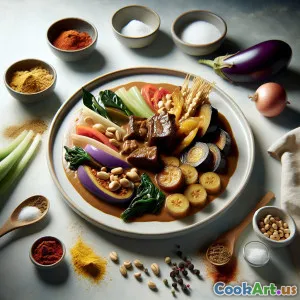
سينيغانغ اللذيذ الحامض - طبق كلاسيكي فلبيني
(Deliciously Tangy Sinigang - A Filipino Classic)
(0 المراجعات)المكونات
-
500 grams لحم بطن الخنزير
(قطع إلى قطع بحجم قضمة)
-
3 tablespoons Tamarind paste
(Adjust based on desired sourness)
-
6 cups ماء
(For the broth)
-
2 medium طماطم
(مفروم)
-
1 medium Radish
(مقطع)
-
1 medium الباذنجان
(مقطع)
-
1 bunch Water spinach (kangkong)
(Washed and trimmed)
-
2 pieces فلفل أخضر
(Whole, for a spicy kick)
-
2 tablespoons صلصة السمك
(للتتبيل)
-
1 teaspoon فلفل أسود
(مطحون طازج)
(قطع إلى قطع بحجم قضمة)
(Adjust based on desired sourness)
(For the broth)
(مفروم)
(مقطع)
(مقطع)
(Washed and trimmed)
(Whole, for a spicy kick)
(للتتبيل)
(مطحون طازج)
التغذية
- الحصص: 4
- حجم الحصة: 1 وعاء (300غ)
- Calories: 320 kcal
- Carbohydrates: 12 g
- Protein: 28 g
- Fat: 18 g
- Fiber: 3 g
- Sugar: 5 g
- Sodium: 800 mg
- Cholesterol: 70 mg
- Calcium: 150 mg
- Iron: 2.5 mg
التعليمات
-
1 - Prepare the Broth:
In a large pot, combine pork belly and water. Bring to a boil, then lower heat and simmer for about 30 minutes.
-
2 - Add Vegetables:
Add tomatoes, radish, and eggplant to the pot. Continue to simmer until vegetables are tender, about 10 minutes.
-
3 - Season the Soup:
Stir in tamarind paste and fish sauce. Adjust seasoning to taste with additional fish sauce or tamarind.
-
4 - Finish with Greens:
Add the water spinach and green chili. Cook for another 2-3 minutes until the greens are wilted.
-
5 - Serve:
Ladle into bowls and serve hot with rice on the side.
In a large pot, combine pork belly and water. Bring to a boil, then lower heat and simmer for about 30 minutes.
Add tomatoes, radish, and eggplant to the pot. Continue to simmer until vegetables are tender, about 10 minutes.
Stir in tamarind paste and fish sauce. Adjust seasoning to taste with additional fish sauce or tamarind.
Add the water spinach and green chili. Cook for another 2-3 minutes until the greens are wilted.
Ladle into bowls and serve hot with rice on the side.
المزيد عن : سينيغانغ اللذيذ الحامض - طبق كلاسيكي فلبيني
Sinigang: A Taste of Home
Sinigang is a beloved Filipino dish known for its sour and savory flavor profile. Traditionally, it features a souring agent, most often tamarind, giving it a unique tang that is both refreshing and comforting. The dish showcases the use of local vegetables and often includes pork, though variations exist with beef or shrimp.
History & Cultural Significance
Sinigang has deep roots in Filipino culture and is often served during family gatherings and celebrations. Its versatility allows for a variety of ingredients, reflecting the unique agricultural landscape of the Philippines. The sourness of sinigang is not just a flavor but a symbol of home-cooked meals, evoking feelings of nostalgia for many Filipinos.
Cooking Tips
When preparing sinigang, it's essential to taste as you go, adjusting the sourness to fit your preference. If tamarind is not available, other souring agents like calamansi or green mango can be used. Additionally, adding green chilies can enhance the flavor and provide a gentle heat.
Sinigang is best enjoyed with a steaming bowl of rice, making it a wholesome meal. It is often regarded as comfort food, especially during rainy days or when one is feeling under the weather. With its rich flavors and nutritious ingredients, sinigang remains a staple in Filipino households and continues to be a favorite among many.
















